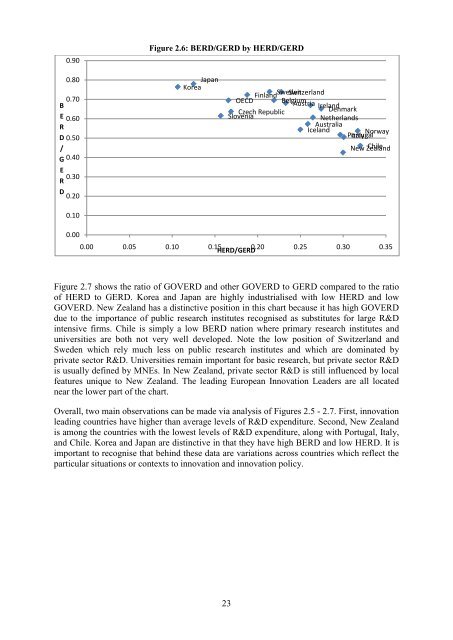Comparison of innovation policies in selected European, Asian and ...
Comparison of innovation policies in selected European, Asian and ...
Comparison of innovation policies in selected European, Asian and ...
You also want an ePaper? Increase the reach of your titles
YUMPU automatically turns print PDFs into web optimized ePapers that Google loves.
B<br />
E<br />
R<br />
D<br />
/<br />
G<br />
E<br />
R<br />
D<br />
0.90<br />
0.80<br />
0.70<br />
0.60<br />
0.50<br />
0.40<br />
0.30<br />
0.20<br />
0.10<br />
0.00<br />
Figure 2.6: BERD/GERD by HERD/GERD<br />
Japan<br />
Korea<br />
Figure 2.7 shows the ratio <strong>of</strong> GOVERD <strong>and</strong> other GOVERD to GERD compared to the ratio<br />
<strong>of</strong> HERD to GERD. Korea <strong>and</strong> Japan are highly <strong>in</strong>dustrialised with low HERD <strong>and</strong> low<br />
GOVERD. New Zeal<strong>and</strong> has a dist<strong>in</strong>ctive position <strong>in</strong> this chart because it has high GOVERD<br />
due to the importance <strong>of</strong> public research <strong>in</strong>stitutes recognised as substitutes for large R&D<br />
<strong>in</strong>tensive firms. Chile is simply a low BERD nation where primary research <strong>in</strong>stitutes <strong>and</strong><br />
universities are both not very well developed. Note the low position <strong>of</strong> Switzerl<strong>and</strong> <strong>and</strong><br />
Sweden which rely much less on public research <strong>in</strong>stitutes <strong>and</strong> which are dom<strong>in</strong>ated by<br />
private sector R&D. Universities rema<strong>in</strong> important for basic research, but private sector R&D<br />
is usually def<strong>in</strong>ed by MNEs. In New Zeal<strong>and</strong>, private sector R&D is still <strong>in</strong>fluenced by local<br />
features unique to New Zeal<strong>and</strong>. The lead<strong>in</strong>g <strong>European</strong> Innovation Leaders are all located<br />
near the lower part <strong>of</strong> the chart.<br />
Overall, two ma<strong>in</strong> observations can be made via analysis <strong>of</strong> Figures 2.5 - 2.7. First, <strong><strong>in</strong>novation</strong><br />
lead<strong>in</strong>g countries have higher than average levels <strong>of</strong> R&D expenditure. Second, New Zeal<strong>and</strong><br />
is among the countries with the lowest levels <strong>of</strong> R&D expenditure, along with Portugal, Italy,<br />
<strong>and</strong> Chile. Korea <strong>and</strong> Japan are dist<strong>in</strong>ctive <strong>in</strong> that they have high BERD <strong>and</strong> low HERD. It is<br />
important to recognise that beh<strong>in</strong>d these data are variations across countries which reflect the<br />
particular situations or contexts to <strong><strong>in</strong>novation</strong> <strong>and</strong> <strong><strong>in</strong>novation</strong> policy.<br />
23<br />
F<strong>in</strong>l<strong>and</strong><br />
Sweden Switzerl<strong>and</strong><br />
OECD Belgium Austria Irel<strong>and</strong><br />
Czech Republic<br />
Denmark<br />
Slovenia<br />
Netherl<strong>and</strong>s<br />
Australia<br />
Icel<strong>and</strong><br />
Norway<br />
Portugal Italy<br />
New Zeal<strong>and</strong> Chile<br />
0.00 0.05 0.10 0.15<br />
HERD/GERD<br />
0.20 0.25 0.30 0.35

















